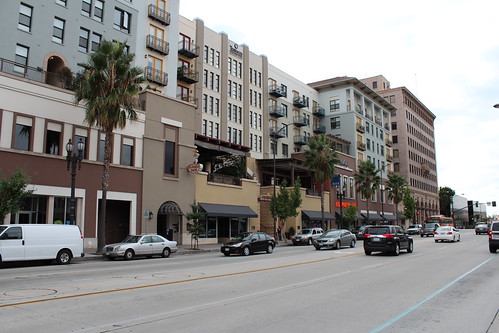
The city of Pasadena, Calif., may narrow Colorado Boulevard (aka Route 66) to make it more friendly for pedestrians and cyclists, reported the Los Angeles Times.
Pasadena is considering plans to narrow portions of Colorado by as much as two lanes and use that space to widen sidewalks and create tiny parks with seating and greenery. The proposal has generated wide support among some city leaders and is expected to go before the City Council soon. […]
The effort to put Colorado on what some planners call a street “diet” reflects a transformation that began a decade ago. Once largely a retail strip, the boulevard, especially in Pasadena, has seen an influx of apartment and condominium complexes, with more than 1,000 residential units added along Colorado since 2003 and an additional 2,000 within three blocks.
And more is on the way, including several hotels. A 175-room hotel has been proposed for the site of the empty Macy’s at the Paseo Colorado and 500 hotel rooms on two sites previously used as a Ford dealership at Colorado and Hill Avenue. Also in the works is a $75-million to $100-million renovation of the 155-room, 1920s-era Constance Hotel at Colorado and Mentor Avenue.
City leaders say that with this development, Colorado needs to better balance the car and the pedestrian.
Narrowing streets for pedestrian and bicycle use has become a trend in many large cities in America. The idea is that such street structures actually boost businesses there because it encourages more walkers who shop. But Pasadenans also are concerned a narrowed street would cause traffic jams.
The key to success for this proposal is to ensure steadier traffic flow. Colorado Boulevard right now is a series of stop lights. If you’re going to build a narrower street, you’d better install roundabouts that would improve flow and compensate for the loss of lanes. I’m not sure whether Pasadena’s city fathers have this in mind.
Incidentally, this report was the first I’ve heard about the renovations of the Constance Hotel, built in 1926 — the same year Route 66 was federally certified. Its website remains rudimentary, but it posted this computer animation of what the fixed-up hotel will look like:
(Image of Colorado Boulevard in downtown Pasadena, Calif., by Matt’ Johnson via Flickr)
I’ve been keeping an eye on the Constance for some time, and have been watching the narrowing of Colorado in Pasadena for several days since I first saw the story break.
The Constance rehab seemed to have started about four or so years ago. It’s been a very LENGTHY process. The building at the left of the wide shot is the original structure, with everything on the remainder of the block essentially being new build-out. Most recently that building was home to senior housing. This will hopefully continue to move forward and bring another option for travelers closer to the original terminus in Downtown LA. Its close proximity to light rail will certainly make touring LA 66 on mass transit a much more entertaining option.
As for the Colorado changes, I currently have mixed opinion. Improving traffic flow on this stretch of road can be done with a mixture of ideas. First and foremost, Pasadena needs to synchronize its signals. This is probably the worst place I’ve seen for that. But what I would REALLY push if I were Pasadena would be the use of Union to the north and Green to the south as through routes from Pasadena City College to the east to Pasadena Avenue on the west. These two streets are one way and have somewhat synchronized lights already. This could allow Colorado to be narrowed along its entire length, opening up bicycle lanes, wider pedestrian paths, and sitting areas for restaurants and other businesses, while also maintaining access to adequate width for the annual Rose Bowl Parade. This will ONLY work, however, if appropriate signage is placed at each end directing travelers to the through routes to the north and south.